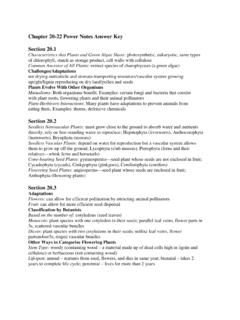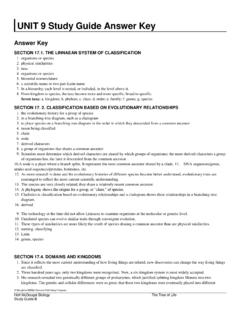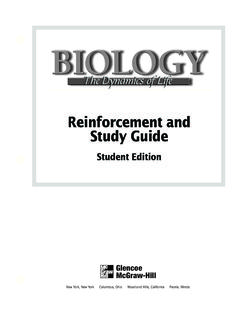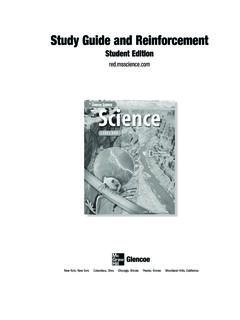Transcription of Chapter 3 Worksheet Answer Keys - Weebly
1 Answer Key Section cell membrane; contains cytoplasm; tends to be study guide microscopic in size. 1. first to identify cells and name them 8. a jellylike substance 2. observed live cells and that contains dissolved observed greater detail molecular building blocks 3. concluded that plants are and, in some types of cells, made of cells organelles 4. concluded that animals and, 9. in the cytoplasm in fact, all living things are 10. cell theory made of cells 11. prokaryotic cells 5. proposed that all cells come from other cells 6. All organisms are made of cells. All existing cells are produced by other living cells. The cell is the most basic unit of life.
2 7. answers will vary. Sample Answer : Cell theory is one of the great unifying theories of biology. Cell Copyright by McDougal Littell, a division of Houghton Mifflin Company theory helped people understand that life didn't arise from nonliving sources. Y diagram: Eukaryotic cells surrounded by a cell membrane;. contains cytoplasm;. contains a nucleus;. contains membrane-bound organelles; tends to be microscopic in size;. eukaryotic organisms may be single-celled or multicellular; Prokaryotic cells surrounded by a cell membrane; contains cytoplasm; tends to be microscopic in size;. prokaryotic organisms are single-celled;. Both surrounded by a Answer Key 1.
3 Answer Key Section 14. All cells are surrounded study guide by a cell membrane that is flexible and interacts with 1. The cytoskeleton supports the environment. Only and shapes the cell, certain cells have a cell positions and transports wall, which is rigid and organelles, provides provides shape and support strength, assists in cell to cells. division, and aids cell 15. They enable plants to movement. convert solar energy into 2. The cytoskeleton supports energy-rich molecules that and shapes the cell. cells can use. 3. The cytoskeleton helps the cell move. 16. endoplasmic reticulum 17. mitochondrion 4. stores most of the genetic information of a cell.
4 Contains the nucleolus, where ribosomes are assembled 5. endoplasmic reticulum 6. link amino acids together to form proteins 7. processes, sorts, and Copyright by McDougal Littell, a division of Houghton Mifflin Company delivers proteins 8. vesicles 9. supply energy to the cell by converting molecules from food into usable energy 10. stores materials needed by a cell; may help provide support to plant cells 11. contains enzymes that break down damaged and worn-out cell parts; defends a cell from invaders 12. organizes microtubules to form cilia and flagella for cell motion or the movement of fluids past a cell 13. The cell walls are strong and rigid and adhere to each other, which helps to support the entire plant.
5 Answer Key 1. Answer Key Section emphasizes both the fluidity study guide of the membrane and the variety of molecules that 1. Student should draw and make up the membrane. label: phosphate group;. 17. selective permeability glycerol; fatty acid. 2. the charged phosphate and glycerol 3. the fatty acid tails 4. polar 5. outside the cell because of the extracellular fluid and inside the cell because of the cytoplasm 6. The polar heads interact with the watery environments both inside and outside the cell. The nonpolar tails interact with each other inside the membrane. 7. strengthen the cell membrane Copyright by McDougal Littell, a division of Houghton Mifflin Company 8.
6 Help materials cross the membrane, part of the cytoskeleton 9. help identify cell types 10. The phospholipids in each layer can move from side to side and slide past each other. 11. Refer to Figure for visual Answer . 12. receptor 13. ligand 14. intracellular 15. membrane, changes 16. The fluid mosaic model is a description of the arrangement of the molecules that make up a cell membrane. It Answer Key 1. Answer Key Section study guide 1. the difference in the concentration of a substance from one location to another 2. The molecule diffuses from an area of higher concentration into an area of lower concentration. 3. diffusion 4. osmosis 5. the movement of molecules down a concentration gradient 6.
7 The natural motion of particles 7. energy from the cell 8. lower 9. hypertonic 10. hypotonic Copyright by McDougal Littell, a division of Houghton Mifflin Company 11. It occurs through selective transport proteins, not simply across the membrane. 12. down a concentration gradient 13. concentration gradient 14. Just as a hyper person has a higher level of energy than most people, a hypertonic solution has a higher level of solutes than the solution it is being compared to. 15. The transport protein makes it easier for a molecule that cannot directly cross the cell membrane to enter or exit a cell. Answer Key 1. Answer Key Section is a process that takes study guide substances into a cell.
8 11. active transport 1. Active transport is the movement of molecules against a concentration gradient, whereas any type of diffusion is the movement of molecules down a concentration gradient. 2. Both involve the movement of molecules through selective membrane proteins. 3. All transport proteins span the membrane, and most change shape when they bind to a target molecule or molecules. 4. Active transport proteins use chemical energy to move a substance against its concentration gradient. Copyright by McDougal Littell, a division of Houghton Mifflin Company 5. Refer to Figure for visual Answer . 6. ATP. 7. vesicles 8. lysosomal enzymes Y diagram: Endocytosis uses energy, takes substances into a cell, moves substances in vesicles; Exocytosis uses energy, releases substances outside a cell, moves substances in vesicles.
9 Both use energy, move substances in vesicles. 9. phagocytosis 10. Exocytosis is a process that releases substances outside a cell. Endocytosis Answer Key 1.










